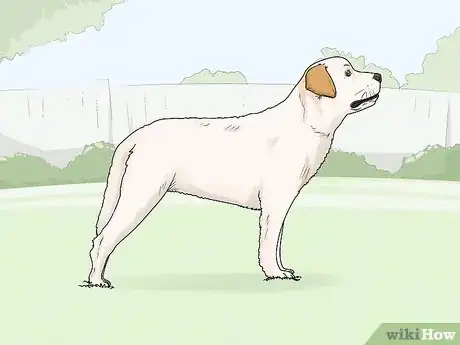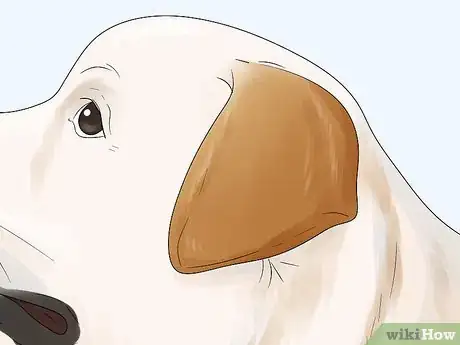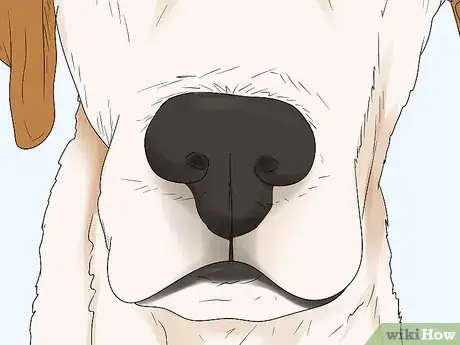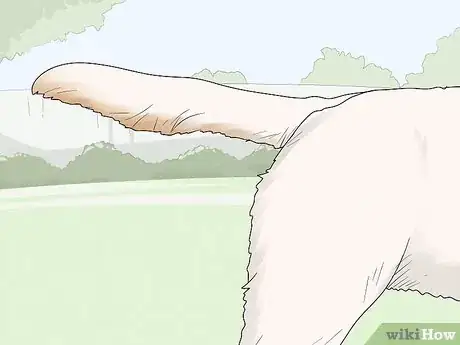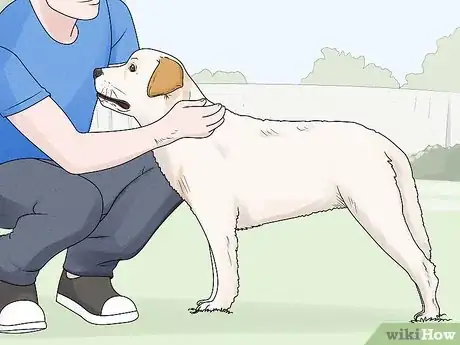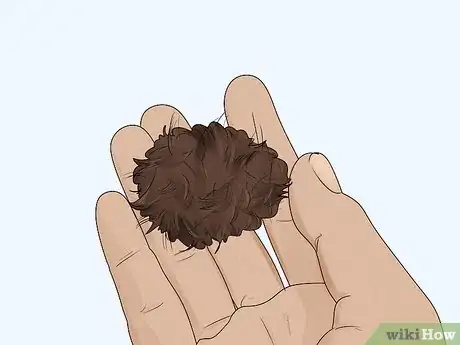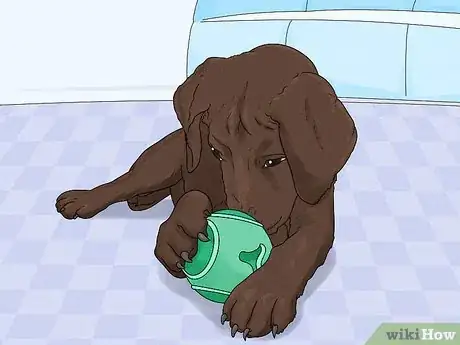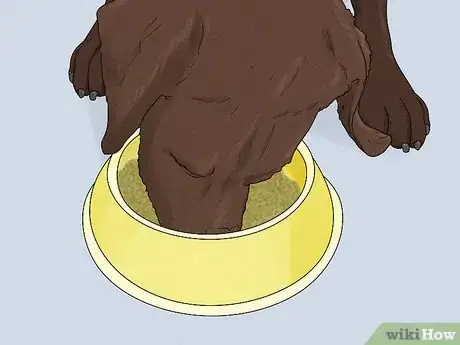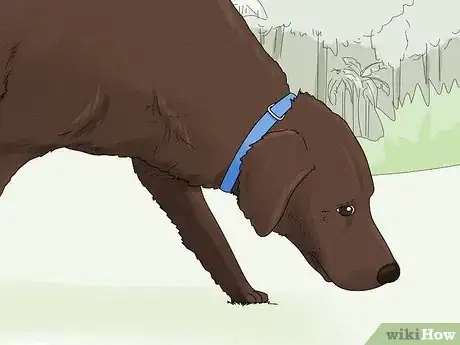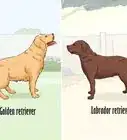X
wikiHow is a “wiki,” similar to Wikipedia, which means that many of our articles are co-written by multiple authors. To create this article, volunteer authors worked to edit and improve it over time.
There are 11 references cited in this article, which can be found at the bottom of the page.
This article has been viewed 38,974 times.
Learn more...
Labrador Retrievers are working dogs, and members of the sporting group.[1] They’re also the most popular breed in the United States, and they make great family pets. This wikiHow will provide you with some information on identifying whether or not a dog is a Labrador Retriever.
Method 1
Method 1 of 3:
Noticing the Body Structure
-
1Check the size of the dog. Labrador Retrievers, on average, are medium-sized dogs. Male Labrador Retrievers are generally anywhere from 22.5–24.5 inches (57–62 cm) tall, and they usually weigh anywhere from 65–80 pounds (29–36 kg), whereas female Labrador Retrievers generally are a little smaller, and generally anywhere from 21.5–23.5 inches (55–60 cm) tall, and they usually weigh anywhere from 55–70 pounds (25–32 kg). [4]
-
2Notice the dog’s ears. A Labrador Retriever’s ears are far back, and hang relatively close to their head. [7]
-
3Check the eyes of the dog. The eyes are medium-sized, relatively far apart, and their color varies, depending on the type of Labrador Retriever. Black and Yellow Labrador Retrievers usually have brown eyes with a black eye rim, where as Chocolate Labrador Retrievers will usually have either brown or hazel eyes, with a brown eye rim. [8]
- The eyes also give off the appearance of the dog being friendly, and this is one of the dog’s distinguishing features. [9]
-
4Notice if the dog has a black or brown nose. Black or Yellow Labrador Retrievers will generally have black noses, whereas Chocolate Labrador Retrievers will usually have a brown nose. Labrador Retrievers won’t typically have a pink or uncolored nose. [10]
-
5Look at the dog’s tail. This is regarded as one of the identifying characteristics of the dog, due to its structure. The tail is thick at the bottom, and gradually gets thinner towards its tip. Because of this unique structure, the tail is often referred to as an “otter” tail. [11]
-
6Check the overall body structure of the dog. Labrador Retrievers have a strong build, and a relatively normal gait, with their legs appearing to be in a parallel line as they’re walking. [14]
- The American Labrador Retriever will generally have a longer, thinner neck, as well as a more narrow head. [15]
Advertisement
Method 2
Method 2 of 3:
Looking at the Coat
-
1Look for one of 3 colors. As stated earlier on, Labrador Retrievers will generally either have a black, brown (“chocolate”), or yellow coat. [16]
- While these coats may occasionally vary in shade, the Labrador Retriever’s coat is generally a solid color rather than a combination of different colors. [17]
-
2See if the dog has a short, dense, hard coat. It also has a weather-resistant soft undercoat (which you likely cannot see), giving it protection from all types of weather. Both of these things are typical of Labrador Retrievers. [18]
- An English Labrador Retriever will generally have a thicker coat than an American Labrador Retriever. [19]
-
3
Advertisement
Method 3
Method 3 of 3:
Behavior and Temperament
-
1Notice the dog’s friendly, affectionate demeanor. Labrador Retrievers are perhaps most well-known for being very friendly and affectionate, and this is one of the things that makes them a great choice for a family pet. [22]
-
2Look for high energy in the dog. Despite the fact that they’re friendly and affectionate, Labrador Retrievers have a lot of energy and love to play. Because of this high energy, they’ll likely need a lot of exercise.[23]
- Though an English Labrador Retriever will most definitely still have quite a bit of energy, American Labrador Retrievers will generally have more. [24]
- Try a walk or a game of fetch/retrieve if you’re looking for ways to give your Labrador Retriever exercise. [25] Some labs love tug-of war if you give them something worthwhile - but each dog is different.
-
3Anticipate some potential mouthing. Mouthing is basically when the dog chews lightly on something, sometimes your hands, or long sleeves. Be sure that you give your dog plenty of toys to help lessen the occurrence of this. [26]
-
4Notice a love of food. Labrador retrievers generally love to eat a lot of food, and they are more prone to becoming overweight because of this. [27]
-
5Look for focus from the dog, especially when following a scent. Since Labrador Retrievers are generally bred to be working dogs, if they find a scent, they’ll likely stay focused on following it until it finds where it was coming from. [28]
- They’re also known to be very intelligent, for the same reason that they’re a working dog.[29]
Advertisement
Community Q&A
-
QuestionMy 2-month-old Labrador retriever is very skinny, but I am giving her banana with curd and royal food two times in a day each (four meals total). I am worried about her health. Is she okay?
 LinnieTop AnswererLabrador retrievers are known to be strongly built with good muscle, so if your dog does not seem to fit this description and is much slimmer, you should take her to a vet to assess her health. However, assuming she is eating the meals you give her, she is eating a healthy amount if the meals are about two ounces each. Note that it's safe for dogs to eat bananas but only in moderation, so consider that feeding her lots of bananas might cause issues as they are high in sugar.
LinnieTop AnswererLabrador retrievers are known to be strongly built with good muscle, so if your dog does not seem to fit this description and is much slimmer, you should take her to a vet to assess her health. However, assuming she is eating the meals you give her, she is eating a healthy amount if the meals are about two ounces each. Note that it's safe for dogs to eat bananas but only in moderation, so consider that feeding her lots of bananas might cause issues as they are high in sugar. -
QuestionHow do I get my 10 month old Labrador retriever to stop jumping?
 LinnieTop AnswererLabrador retrievers are intelligent, focused dogs, but they, especially when young, are also abundantly energetic. Because of this, you need to train them from an early age not to jump. As dogs that love food, reward-based training, such as the moderated usage of treats, is a great training method for this breed. Check out How to Train Labrador Retrievers for tips on tackling training sessions for this particular breed. For the jumping behavior, try to get the dog to shift into a sitting position if they attempt to jump on someone. Calmly but clearly discourage the behavior in a gentle manner and reward the dog as they obey. Read How to Stop a Dog from Jumping to handle this behavior.
LinnieTop AnswererLabrador retrievers are intelligent, focused dogs, but they, especially when young, are also abundantly energetic. Because of this, you need to train them from an early age not to jump. As dogs that love food, reward-based training, such as the moderated usage of treats, is a great training method for this breed. Check out How to Train Labrador Retrievers for tips on tackling training sessions for this particular breed. For the jumping behavior, try to get the dog to shift into a sitting position if they attempt to jump on someone. Calmly but clearly discourage the behavior in a gentle manner and reward the dog as they obey. Read How to Stop a Dog from Jumping to handle this behavior. -
QuestionI have a 5 year old yellow Labrador retriever, and he is getting a bit obese. I took him to the vet, but my dad doesn't walk him well. I can't walk him because he pulls a lot. What should I do?
 VictoriaTop AnswererIf you are unable to walk your Labrador retriever, you can also help him get exercise through games of fetch and/or time to run around in a fenced-in yard.
VictoriaTop AnswererIf you are unable to walk your Labrador retriever, you can also help him get exercise through games of fetch and/or time to run around in a fenced-in yard.
Advertisement
References
- ↑ https://www.akc.org/dog-breeds/labrador-retriever/
- ↑ https://puppyintraining.com/difference-between-american-and-english-labradors/
- ↑ https://puppyintraining.com/difference-between-american-and-english-labradors/
- ↑ https://www.akc.org/dog-breeds/labrador-retriever/
- ↑ https://www.hillspet.com/dog-care/dog-breeds/labrador-retriever
- ↑ https://www.thelabradorsite.com/english-vs-american-labrador/
- ↑ https://images.akc.org/pdf/breeds/standards/LabradorRetriever.pdf
- ↑ https://images.akc.org/pdf/breeds/standards/LabradorRetriever.pdf
- ↑ https://images.akc.org/pdf/breeds/standards/LabradorRetriever.pdf
- ↑ https://images.akc.org/pdf/breeds/standards/LabradorRetriever.pdf
- ↑ https://images.akc.org/pdf/breeds/standards/LabradorRetriever.pdf
- ↑ https://images.akc.org/pdf/breeds/standards/LabradorRetriever.pdf
- ↑ https://www.thelabradorsite.com/english-vs-american-labrador/
- ↑ https://images.akc.org/pdf/breeds/standards/LabradorRetriever.pdf
- ↑ https://www.thelabradorsite.com/english-vs-american-labrador/
- ↑ https://images.akc.org/pdf/breeds/standards/LabradorRetriever.pdf
- ↑ https://images.akc.org/pdf/breeds/standards/LabradorRetriever.pdf
- ↑ https://images.akc.org/pdf/breeds/standards/LabradorRetriever.pdf
- ↑ https://www.thelabradorsite.com/english-vs-american-labrador/
- ↑ https://labrador-central.com/labrador-retriever-shedding/
- ↑ https://www.everythinglabradors.com/understanding-the-labs-double-coat-do-labradors-shed-a-lot/
- ↑ https://www.akc.org/dog-breeds/labrador-retriever/
- ↑ https://www.akc.org/dog-breeds/labrador-retriever/
- ↑ https://www.thelabradorsite.com/english-vs-american-labrador/
- ↑ https://www.akc.org/dog-breeds/labrador-retriever/
- ↑ https://www.dogtemperament.com/labrador-retriever-temperament/
- ↑ https://www.dogtemperament.com/labrador-retriever-temperament/
- ↑ https://www.dogtemperament.com/labrador-retriever-temperament/
- ↑ https://www.dogtemperament.com/labrador-retriever-temperament/
About This Article
Advertisement

